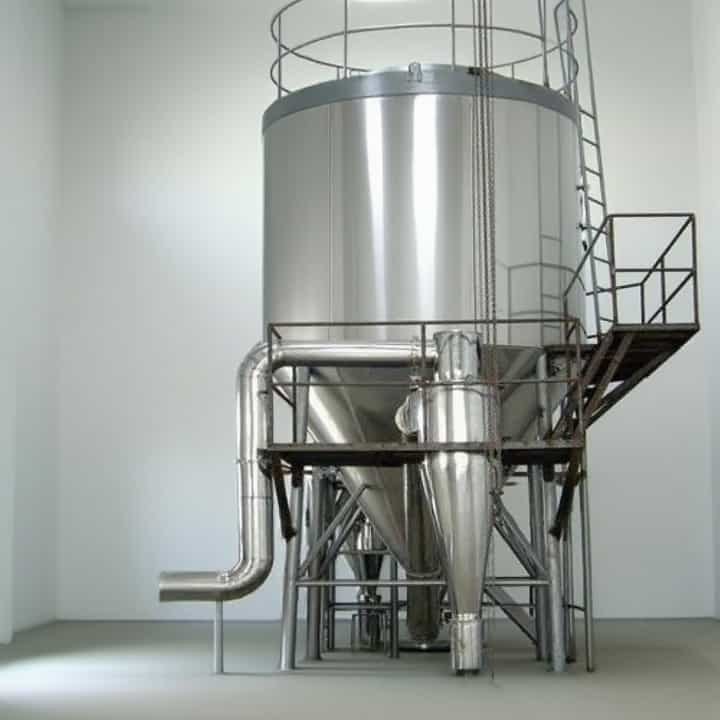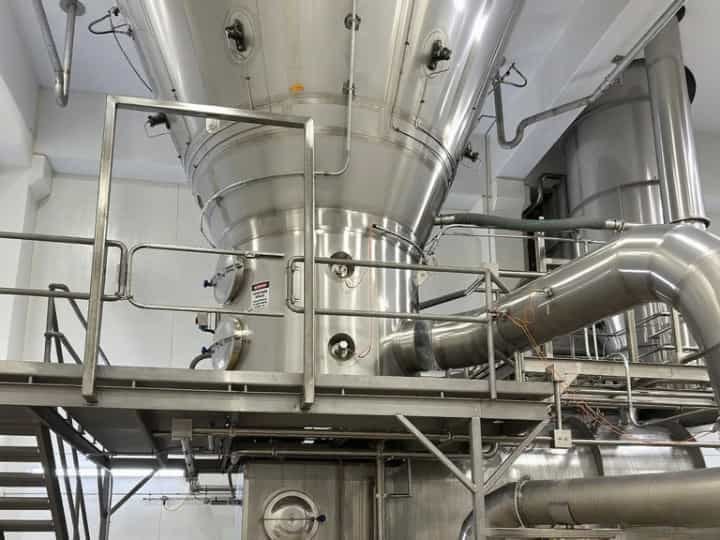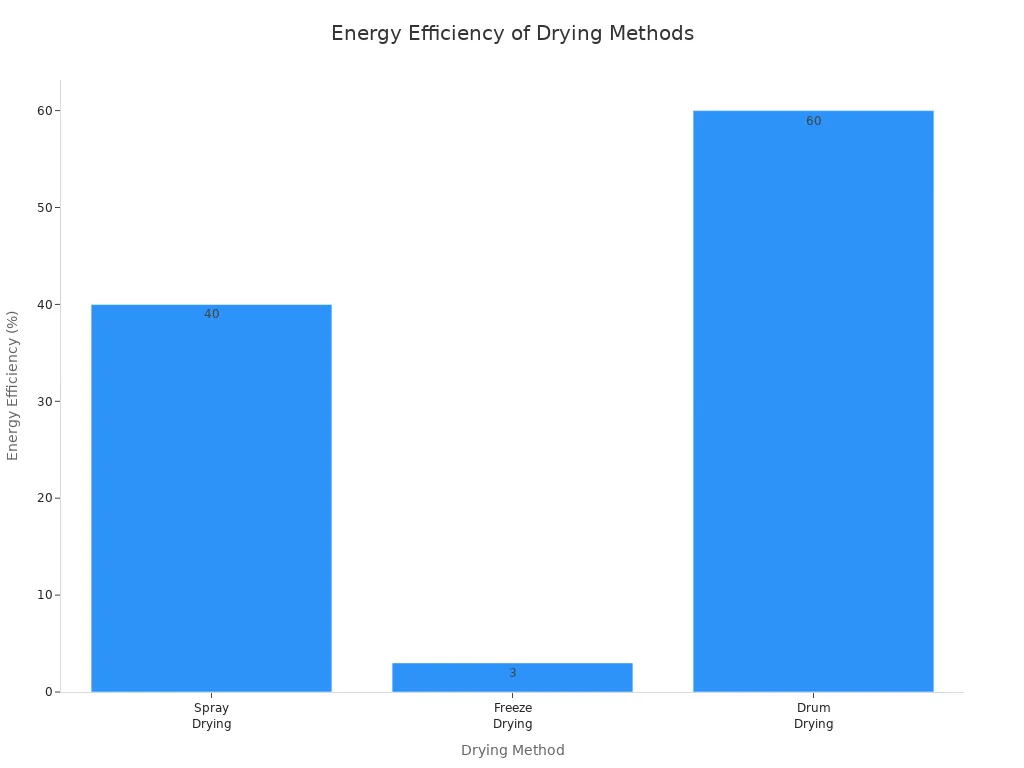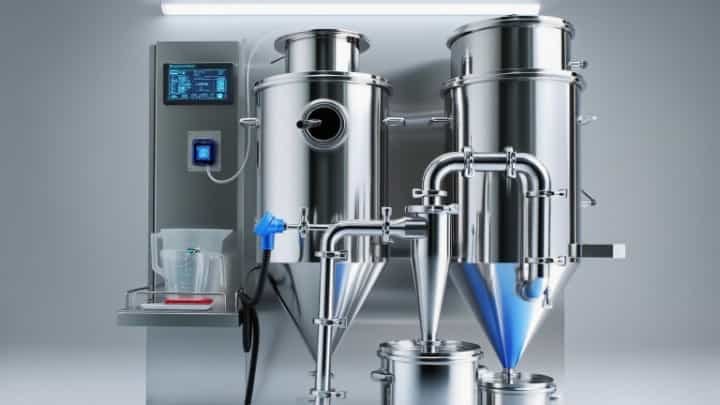A spray dryer helps you change a liquid or slurry into dry powder fast. It only takes a few seconds. Spray drying is used to make things like instant coffee, baby formula, or medicine. These products need to stay fresh and be easy to store. The global spray dryer market was about $6.23 billion in 2024. People want more food, dairy, and medicine, so the market keeps growing.
In the last ten years, spray drying got more popular. People want more ready-to-eat foods and better medicine.
Companies use spray drying for food, medicine, and chemicals. They also use it for plant-based protein powders and special chemicals.
Key Takeaways
Spray dryers change liquids into dry powders fast. This helps products stay good longer and makes them easier to keep. The spray drying process uses hot air and atomizers. These tools make tiny drops that dry quickly. This does not hurt sensitive ingredients. Spray drying saves both time and energy. It is cheaper and works well for making a lot of products. This method is good for many things like food, medicine, and chemicals. It lets people control the powder’s quality and size. Microencapsulation in spray drying keeps nutrients and flavors safe. This helps products last longer and stay stable.
What Should You Know About Spray Dryers?
Spray dryers transform liquid materials into dry powders through a rapid drying process involving hot gas. This method is widely used in food, pharmaceutical, and chemical industries.
What Is a Spray Dryer
A spray dryer is a machine that turns a liquid into a dry powder in just a few seconds. You use it when you want to make products that are easy to store and last longer. The spray dryer works by spraying tiny drops of liquid into a hot air stream. The heat quickly removes the water, leaving behind dry particles.
You can find several types of spray dryers in factories. Each type uses a different way to break up the liquid and dry it. Here is a table to help you see the main types and how they work:
Spray Dryer Type | Atomization Method | Design Features and Applications |
|---|---|---|
Rotary (Centrifugal) Atomization | Spinning wheel | Handles thick or gritty liquids; good for many materials; can use tough parts for hard feeds. |
Pressure Nozzle Atomization | High-pressure pump | Makes even, small powder; common in food and dairy; gives good flow and bulk. |
Two-Fluid Nozzle Atomization | Compressed gas | Uses air and liquid together; makes fine drops; often used in test plants. |
Combination with Fluidized Beds | Spray + fluidized bed | Adds extra drying or cooling; makes clump-free powders; cuts down on dust. |
Closed Cycle | Sealed loop with inert gas | Stops fires; good for flammable liquids; can recover solvents. |
Tip: You can choose the right spray dryer type based on your product and safety needs.
Key Components
Every spray dryer has several important parts. Each part helps you get dry powder from your liquid feed. Here is how each part works:
Feed Pump: Moves your liquid into the spray dryer at a steady rate.
Atomizer: Breaks the liquid into tiny droplets, making drying faster. You can use a nozzle or a spinning wheel.
Air Heater: Warms up the air before it enters the dryer, so the water in your liquid can evaporate quickly.
Air Disperser: Spreads the hot air evenly inside the drying chamber.
Drying Chamber: This is where the magic happens. The droplets meet hot air and turn into powder.
Powder Discharge: Collects most of the dry powder as it falls to the bottom.
Cyclone Separator: Spins the air to catch fine powder that did not fall out in the chamber.
Exhaust Fan: Pulls air through the system and keeps everything moving.
Exhaust Air Outlet with Bag Filter: Filters out any last bits of powder before the air leaves the spray dryer.
Each part works together to give you a fast, safe, and clean way to dry your products.
How Does the Spray Dryer Process Work?
Spray drying changes liquid feed into dry powder in steps. Each step is important for good product quality and efficiency. Let’s see what happens at each stage.

Feed Preparation
First, you get the feed ready. The feed can be a solution, emulsion, or suspension. You might use milk, protein solutions, plant extracts, or chemical slurries. Many foods and medicines use whey protein, gelatin, or modified starch as feed. These help make powders with the right texture and stability.
Before putting the feed in the spray dryer, you must check some things:
Drying temperature: This changes how much water stays in the powder and how fast it dries.
Pump speed (feed rate): Lower speeds make smaller droplets that dry faster.
Air speed: Faster air helps separate particles and changes powder size.
Atomization pressure: More pressure makes smaller droplets.
Feed viscosity: Thicker feeds make bigger droplets.
Surface tension: Higher surface tension also makes bigger droplets.
Inlet temperature of drying air: This controls how fast water leaves the droplets.
Drying air flow rate: This changes how well the process removes water.
Pressure and amount of atomizing air: This changes how droplets form and dry.
You need to set these things to match your product. If you use the right settings, your feed will work well in the next steps.
Note: Spray drying is good for heat-sensitive things like vitamins, enzymes, and flavors. You can keep these safe by picking the right feed and drying settings.
Atomization
Atomization is the next step. Here, you break the feed into tiny droplets. You use an atomizer for this. The atomizer can be a spinning wheel, a nozzle, or an ultrasonic device.
The atomizer you pick changes droplet size and shape. Smaller droplets dry faster, but very small ones can get lost in the air. Rotary atomizers use spinning force to make even droplets. This is good for big jobs. Nozzle atomizers use pressure to push feed through small holes. This lets you control droplet size and spray shape.
Rotary atomizers: Best for making lots of powder and thick feeds.
Nozzle atomizers: Good for fine powders and changing droplet size.
Ultrasonic atomizers: Used for very fine droplets in special cases.
You must set atomizer speed and pressure for your product. The right atomizer helps you control drying, particle size, and powder quality.
Drying Chamber
After you make droplets, they go into the drying chamber. This is where most drying happens. Hot air goes into the chamber and mixes with the droplets. The heat makes water leave fast, so you get dry particles.
The chamber temperature is usually between 100 °C and 180 °C. You must keep the temperature steady. If it is too hot, you can hurt the product or make powder clump. If it is too cold, drying is slow and powder stays wet.
Airflow in the chamber is important too. You want hot air to move evenly around the droplets. Many spray dryers have air inlets on the sides and an outlet at the bottom. This setup makes air move down, keeping temperature and speed even. Good airflow helps drying work better and gives you better powder.
Tip: Keeping the right temperature in the chamber protects heat-sensitive things and keeps your powder free-flowing and stable.
Particle Collection
After drying, you must collect the powder from the air. Drying makes fine particles that float in the air. You use a cyclone separator, bag filter, or other system to catch them.
How you collect powder changes how much you get back. If you use an air aspirator and set it right, you can get more product. You also control inlet temperature, aspirator power, and pump speed for best results.
Most spray dryers use a cyclone separator to spin air and catch powder. Some add a bag filter to catch the last bits before air leaves. This step helps you get as much powder as you can and keeps the air clean.
Note: Changing the collection system and drying settings helps you get more powder and keep it high quality.
What Are the Advantages of Spray Drying?
Spray drying offers several advantages, including high efficiency in moisture removal, the ability to produce uniform and fine particles, and preservation of product quality.

Efficiency
Spray drying is fast and saves money. It can turn liquids into powders in seconds. This process uses energy mostly to heat air. Other drying methods often use more energy and take longer. The table below shows how spray drying compares to other ways:
Drying Method | Energy Efficiency | Energy Use Characteristics | Operational Cost Comparison | Processing Time | Product Quality & Control | Scalability & Sustainability |
|---|---|---|---|---|---|---|
Spray Drying | 30-50% | Moderate energy use, mainly for heating air | Lower operational costs, 4-8 times less than freeze drying | Seconds | Good control, suitable for heat-sensitive materials | Highly scalable; modern systems include heat recovery |
Freeze Drying | 1-5% | High energy use due to freezing, vacuum, sublimation | 4-8 times higher cost per kg water removed | Longer, batch process | Superior quality preservation for sensitive products | Less energy efficient, higher capital investment |
Drum Drying | Higher thermal efficiency | Simple operation, higher thermal damage risk | Lower capital investment | N/A | Limited control, risk of scorched/cooked flavor | N/A |
Microwave Drying | N/A | Volumetric heating, uneven energy distribution | Emerging technology, scalability challenges | Minutes to hours | Potentially better nutrient retention but uneven heating | Scalability challenges |

Spray drying machines can run all the time. This means you get the same results every time and save money. Big spray dryers can dry over 4,000 kg of water each hour. This makes them great for large factories.
Product Quality
Spray drying gives you good powders. You can control the temperature, droplet size, and airflow. This helps protect things like vitamins and flavors. Microencapsulation puts a shield around these nutrients. This keeps them safe from heat and air, so they last longer.
Many things change your final powder:
Feed properties like pH, thickness, and how much solid is in it
Atomization pressure and type
Inlet and outlet temperatures
Gas flow rate and how long it stays inside
If you set these right, your powder will flow well and dissolve fast. It will also keep its nutrients. You can stop burning or clumping, which can happen with other drying ways.
Note: Spray drying is good for things that do not like heat. Drum drying can burn or cook the powder.
Versatility
Spray drying works for many products. You can use it for food, dairy, chemicals, and medicine. It can handle solutions, emulsions, and slurries. You can make powders from coffee, milk, vitamins, detergents, and plant proteins.
Pilot units help you try new ideas before making a lot.
You can change the process to get the right powder size and moisture.
Tip: Spray drying is flexible, but works best for certain powder sizes and moisture. Very sticky or big particles may need extra steps.
Where Is Spray drying Commonly Used?
Spray drying is commonly used in the food, pharmaceutical, and chemical industries. This process helps transform liquid substances into dry powders, enhancing shelf life and stability.

Food Industry
Spray drying is used a lot in food. It helps turn liquids into powders. These powders last longer and are easy to use. You see spray drying in dairy, drinks, and bakery foods. Microencapsulation is important here. It keeps flavors, vitamins, and probiotics safe. This method protects nutrients from heat and air.
Here is a table with foods made by spray drying:
Category | Common Food Products Manufactured by Spray Drying Technology |
|---|---|
Dairy Products | Milk powder (whole, skim), whey protein powders, infant formula |
Beverages & Instant Products | Coffee and tea extracts, fruit juice powders (orange, mango, strawberry) |
Functional Foods & Additives | Probiotics, enzymes, flavorings, colorants |
Egg & Meat Products | Egg powder, meat and fish protein powders |
Bakery & Confectionery | Starch, sweeteners such as glucose and maltodextrin |
Spray drying works in small labs or big factories. This helps food makers try new ideas and keep foods fresh longer.
Tip: Microencapsulation lets you add probiotics or flavors to foods. They stay safe during storage or cooking.
Pharmaceuticals
Spray drying is used to make medicines. It turns liquid drugs into powders fast. This keeps heat-sensitive parts safe. Microencapsulation is very helpful here. It hides bad tastes and controls how medicine works in your body.
Microencapsulation helps medicines last longer and stay stable.
Spray drying makes powders that dissolve quickly and work well.
You can use it for taste masking and slow-release drugs.
It works for many drug types, like solutions and suspensions.
Microencapsulation helps make new drug forms, like inhalable powders.
Spray drying machines are in labs and big drug factories. This makes it easy to make more medicine after testing.
Note: Microencapsulation in medicines helps deliver drugs safely. It can also lower side effects.
Chemicals and Materials
Spray drying is used in chemicals and new materials. It helps make special chemicals, catalysts, and nanomaterials. Microencapsulation protects sensitive parts and controls how they work.
You can make even powders for paints, ceramics, and batteries.
Microencapsulation helps store and use reactive chemicals safely.
Spray drying makes nanoparticles for things like medicine or electronics.
You can change the process to get the right size and shape.
Spray drying is used in small labs and big chemical plants. This makes it a good choice for new materials and special chemicals.
Tip: Microencapsulation in chemicals helps products work better and last longer.
Spray drying lets you change liquids into powders fast and safely. This way saves time and money. It also makes good powders for many things.
New ideas include smart machines, easy-to-move parts, and saving more energy.
You can control your product better, have more choices, and stay safer.
Benefit | Spray Drying | Freeze Drying |
|---|---|---|
Seconds | Hours | |
Operating Cost | Lower | Higher |
Scalability | High | Limited |
As technology gets better, spray drying will improve too. Think about how spray drying could help you at school or work.
FAQ
What products can you make with a spray dryer?
You can make milk powder, instant coffee, protein powders, medicine, and chemicals. Spray dryers help you turn many liquids into powders. You can use them in food, medicine, and chemical factories.
How do you clean a spray dryer?
You should clean the spray dryer after each use. Use water or a cleaning solution. Make sure you remove all powder from the chamber, nozzles, and filters. This keeps your products safe and your machine working well.
Is spray drying safe for vitamins and flavors?
Yes, spray drying protects vitamins and flavors. You can control the temperature and drying time. This helps keep nutrients and tastes strong. Many companies use spray drying for heat-sensitive ingredients.
Can you use spray drying for small batches?
You can use spray drying for small batches in labs or pilot plants. Small spray dryers help you test new products before making large amounts. This saves time and money.

